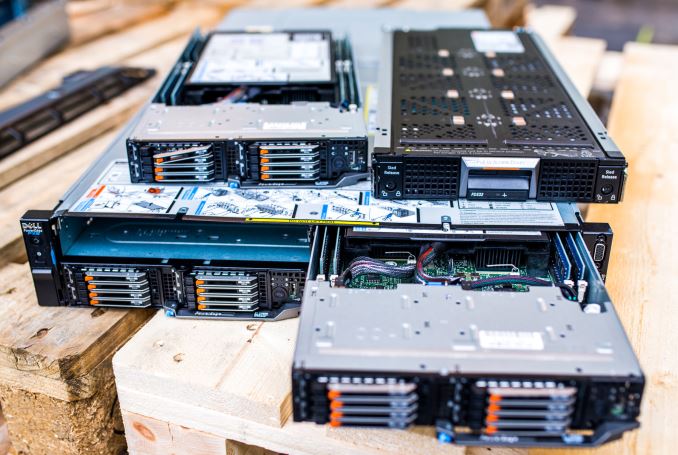The Evolution of HDDs in the Near Future: Speaking with Seagate CTO, Mark Re
by Anton Shilov on July 6, 2016 2:00 PM ESTNew 10K and 15K RPM HDDs Incoming
Hard drives with 10K and 15K spindle speeds are used to store mission-critical applications and data that also require high performance. Such drives typically use a SAS interface with its advantages over SATA/AHCI. Plenty of legacy systems and setups still rely on these fast hard drives, and as a result these systems are not going to be decommissioned in the near future. Nonetheless, the total available market for ultra-fast HDDs with 10K and 15K RPM spindle speeds has shrunk in the recent years due of SSDs. This does not mean that speedy HDDs no longer evolve - Seagate informed us that it is preparing another generation of 10K and 15K RPM HDDs.
Seagate’s new generation of 10K hard drives will not only feature 10K RPM spindle speed as per the name, but also TDMR technology — two readers per head. Those readers will read one track to improve signal to noise ratio and enable higher capacities. Keeping in mind that we are talking about critical storage applications, HDDs with two readers per arm will keep using PMR or SMR recording technology, but eventually the tech could be used for HAMR-based drives.
When it comes to 15K HDDs, Seagate seems to be somewhat more humble or secretive. The company did confirm that it is working on at least one more generation of 15K hard drives. The high-performance SAS deployments are already there and someone needs to serve them, which is where the next-generation 15K HDDs may come in handy. Moreover, SNIA has a long roadmap for SAS towards 24 Gb/s transfer speeds and the year 2020 ahead of it, which is why it is important for Seagate to offer both HDD and SSD solutions for this market. The next generation of 15K HDDs could be the last generation of such hard drives, which is why it will have to offer a balance of features and technologies that Seagate does not want to discuss at this time. Perhaps, not because of competitive reasons, but because it is working with its customers to enable features that they need.
Nonetheless, as new data center platforms arrive, the need for 15K HDDs will inevitably decrease and Seagate understands that. For example, Intel’s latest SSDs for mission-critical applications rely on PCIe bus and NVMe protocol. As a major provider of ultra-high-end Nytro storage accelerators, Seagate will naturally follow market’s trends, but this is a topic to be covered by an SSD-related conversation.











91 Comments
View All Comments
mkozakewich - Thursday, July 7, 2016 - link
Oh, I remember that article. Higher write temperatures mean better longevity, right?twelvebore - Wednesday, July 6, 2016 - link
Guessing that you don't buy storage by the petabyte then? You know, horizons and all that.Ushio01 - Wednesday, July 6, 2016 - link
With 2.5" SSD's available today offer lower power, higher capacity, higher performance and higher density than 3.5" HDD's. I wonder how much that offsets the higher cost per GB?twelvebore - Wednesday, July 6, 2016 - link
Higher capacity? A 10TB 2.5" SSD for <£500? Where?Lower power than an HDD that's powered off?
Performance doesn't always matter.
The article says several times, this is not about desktop. This is about data-centre, extreme capacity, price-sensitive. These HDDs are competing with magnetic tape, not SSD.
jwhannell - Wednesday, July 6, 2016 - link
Flape.patrickjp93 - Wednesday, July 6, 2016 - link
Performance/Watt/$ is the most important metric, and HDD is already under immense pressure from archival SSDs.patrickjp93 - Wednesday, July 6, 2016 - link
For enterprise use that's a $2000 drive, unless you're using one without power loss protection and ECC... And Samsung already has one provided.Murloc - Wednesday, July 6, 2016 - link
It doesn't offset the cost at all if the only thing that matters is $/GB.amnesia0287 - Wednesday, July 6, 2016 - link
You don't seem to understand how datacenters work. SSDs and modern JBOD infrastructure are changing the way this is approached. The thing you gotta realize is you can pack SSDs INSANELY dense. Yes, the power difference of 1 ssd is menial, but when you fill a rack with them, the combined power and cooling savings add up, especially if you are aiming for a minimum 2-3 year run cost.You also have to bear in mind that datacenters are pretty much exclusively using substantially more expensive (and hotter/louder) SAS drives.
Capex is important, but you are totally ignoring Opex and TCO. Also AFR is about 1/6th (.5% vs 3%) which gives you more flexibity in your planing for consistency/redundancy. SSD failures are more or less predictable.
Either way the move to SSDs in the datacenter is VERY real, as density is king. Why waste money expanding into more datacenters and adding more racks? SSDs also solve alot of problems that HDD have such as large array rebuilds.
Also tech like RDMA combined with NVMe virtualization is going to fundamentally change the landscape.
zodiacfml - Friday, July 8, 2016 - link
Correct. SSDs have higher density already and the rich companies can afford them.